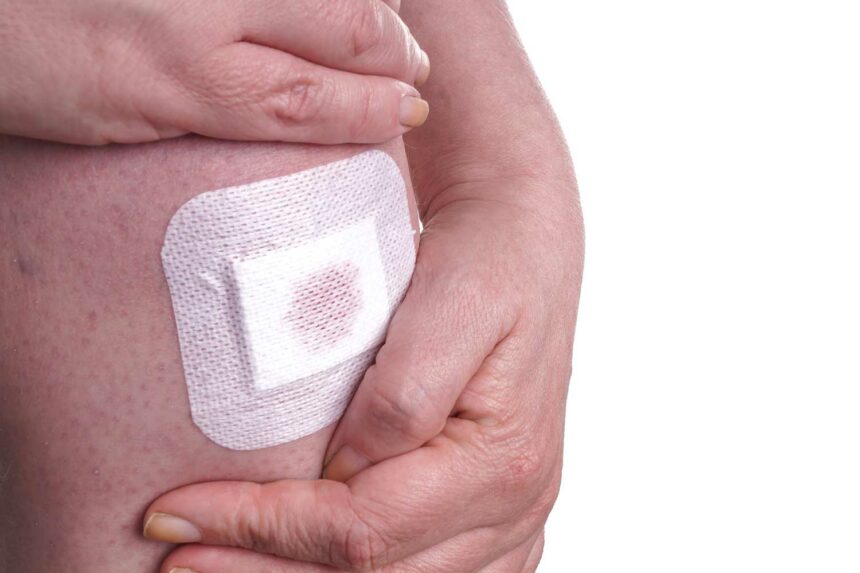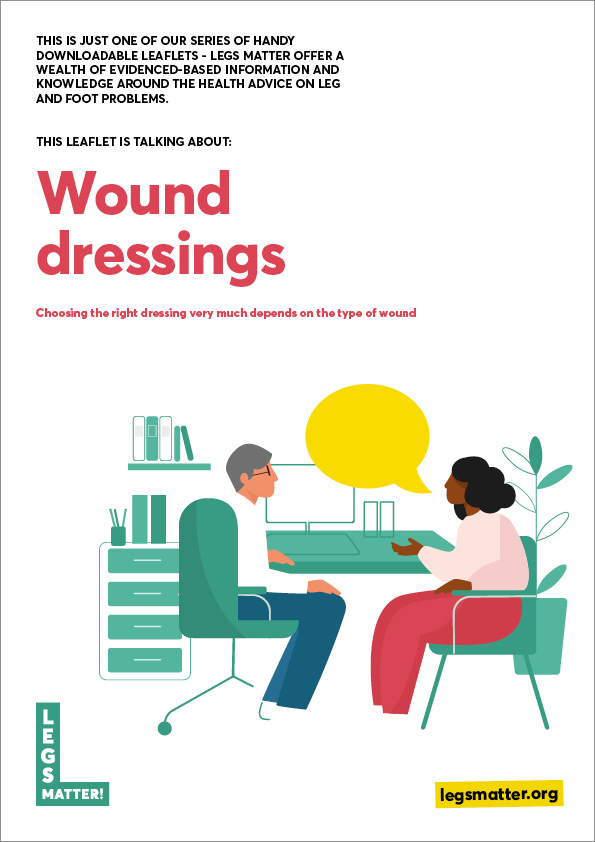How can wound dressings help with leg and foot conditions?
Dressings are an essential part of a person’s leg or foot wound care plan, but it is important that a robust lower limb / foot assessment has been carried out before dressings are selected to help identify any underlying factors that may impact on healing. This could include venous disease (problems with the veins), peripheral arterial disease (problems with the blood flow in the arteries to the legs and feet) or neuropathy (problems with the nerves in the legs / feet). Certain diseases such as diabetes or renal disease can sometimes slow down healing, abnormalities in blood chemistry such as anaemia, malnutrition or some medication may also affect healing potential. Unless these underlying problems are identified and treated, dressings will often prove ineffective to healing.
The role of a wound dressing is to provide the optimum conditions for wound healing, whilst protecting the wound from further trauma and infection. It is also important that the dressings can be removed without causing trauma, to prevent further damage to the wound surface during dressing changes.
What is known is that wounds are more susceptible to healing in a moist, clean, and warm environment. A moist wound bed will allow new tissues to grow from the base of the wound upwards and for epithelial cells (new skin) to form from the edges of the wound helping the wound to close.
Debridement is often used to remove devitalised tissue and prepare the wound for healing – this could be adherent, dead or contaminated tissue within the wound eg slough, necrosis or biofilm. There are various techniques for debridement using dressings which are mentioned below.
There are also more specialist dressing therapies such as Negative Pressure Wound Therapy (NPWT), also known as Vacuum Assisted Closure (VAC).
How to choose the correct wound dressing
To create and maintain this environment, appropriate dressings are required. There are four basic principles involved in choosing an optimal dressing.
- If a wound is too dry, it will need hydration.
- If a wound produces excessive exudates (wound fluid), this needs to be absorbed.
- If a wound has necrotic (dead) tissue or slough (yellow debris), it will need debridement.
- If a wound is infected, it needs to be treated with the appropriate antibacterial agent.
There are also several other factors that are important when choosing a dressing, such as providing protection to the surrounding skin, being conformable to the wound and anatomical body shape, producing minimal pain when in place and during application and removal, being irritant free, not releasing particles or nonbiodegradable fibres into the wound, and maintaining the wound at an optimal temperature and pH.
There should always be a dressing available to meet the needs of the patient and their wound. It is important to remember that as the wound environment changes the dressing also needs to change.
Dressings come under various categories. When selecting a dressing, it is important to have knowledge about its mode of action to ensure it is appropriate for the wound type / status.
What are film dressings?
Transparent film dressings are thin flexible transparent sheets with adhesive backing, made from polyurethane or co-polyester. They are permeable to water vapor, oxygen, and carbon dioxide but impermeable to bacteria and water. They provide a moist healing environment and promote autolytic (natural) debridement. They are not able to absorb fluid therefore should not be used for wounds with excessive exudate (wound fluid). This material should not cover infected wounds because bacteria can multiply without adequate drainage.
What are foam dressings used for?
Foam dressings are made from a polyurethane base and are permeable to both gases and water vapour. This material is attracted to water so allows wound exudate to be absorbed into the dressing whilst also providing thermal insulation. These dressings can be used for wounds with moderate-to-high levels of exudate, and those that are granulating or sloughy. They can also be used on infected wounds. They are not recommended for dry, or eschar (dry necrosis) covered wounds due to their ability to dry wounds further. They can be left in place for up to 4–7 days but should be changed once saturated with exudate.
What type of wound requires a hydrogel dressing?
The main function of these dressings is hydrating dry wound beds and softening and loosening slough and necrotic wound debris. Hydrogels are gel dressings consisting of an 80%–90% water base. These gels are available in a tube or in a flexible sheet form. They can absorb a minimum amount of fluid by swelling, but they also can donate moisture to a dry wound, thereby assisting autolytic debridement and maintaining a moist wound environment that is thermally insulated. They are unable to absorb heavy drainage due to their high-water concentration; they absorb very slowly and therefore are not useful on bleeding wounds, and they generally require a secondary dressing. Maceration can be of concern, as surrounding skin areas need to be protected from excess hydration, because of this they are not recommended for treatment of diabetic foot ulcers. Hydrogels need to be covered with secondary dressings while remaining in place for up to 3 days.
What are hydrocolloid wound dressings?
Hydrocolloid dressings contain an inner layer that is self-adhesive, gel forming, and composed of particles that are attracted to water (for example, carboxymethylcellulose (CMC), pectin, gelatine, or an elastomer). This layer absorbs wound fluid and swells into a gel-like mass over the wound. This allows for a moist healing environment and provides thermal insulation to the wound bed. The outer layer, which usually consists of polyurethane, seals, and protects the wound from bacteria, foreign debris, and shearing. These dressings are available in a variety of sizes and shapes and come in a paste, powder, or granule form.
These dressings have an ability to provide a moist healing environment, prevent contamination, promote autolytic debridement, and not require a secondary dressing. They can remain in place for up to 7 days or until drainage is noted from beneath the dressing. They can be used on wounds with low-moderate exudates, granulating, sloughy and necrotic wounds. They must be avoided in clinically infected wounds and are not recommended for ischaemic / diabetic foot ulcers. Caution should also be taken in fragile surrounding skin as the adhesive may cause further damage.
What is an alginate dressing?
Alginates are often used on wounds that have a high level of exudate (wound fluid). They contain alginic acid from seaweed and are covered in calcium / sodium salts. These dressings are highly absorbent, non-adherent, biodegradable and contain non-woven fibres derived from brown seaweed. When placed on a wound, sodium and calcium ions interact with the wound fluid to form a gel. Alginates are useful because they allow formation of a moist wound environment, are highly absorptive, and can prevent bacterial contamination.
Alginates are capable of absorbing 20 times their weight, although this may vary depending on a particular product. These dressings are particularly effective for managing highly wet wounds. Alginates have also been known to have haemostatic properties that make them useful on bleeding wounds. These dressings should not be used for dry wounds. In clean wounds, they may be kept in place for up to 7 days. Alginate dressings are produced in sheet form and as ribbon or rope.
What is a hydrofiber dressing?
Hydrofibers are structurally like alginates and have many of the same properties, however they have additional carboxymethylcellulose (CMC) fibres which gives the dressing more tensile strength and makes it more absorbent. They are comfortable, easy to remove, and are suitable for heavily exudating or infected wounds. Hydrofibers have been proven to be effective in reduction of Matrix Metalloproteases (MMPs / harmful enzymes) and bacteria levels due to their highly absorptive nature.
What are absorbent pad dressings used for?
These are commonly used as a secondary dressing (a second layer). They are designed to absorb exudate (wound fluid), preventing the wound from remaining too wet which can cause damage to the new tissue and the surrounding skin. There are different types of absorbent pads:
- Simple pad – containing a blend of cellulose pulp
- Extra absorbent pad – This contains cellulose pulp but has additional superabsorbent particles that swell on contact with wound fluid
- Super absorbent polymer dressings (SAPs) – These absorbent pads contain polymers that can absorb several hundred times its own weight in water. They are used for wounds that are very highly exuding
How do you use a wound contact layer dressing?
These dressings are used as primary dressings (the layer that goes against the wound) and can be used in isolation or with a secondary dressing (second layer). They should be atraumatic (should not adhere) and should provide a good healing environment for wound healing. Some contact layers are very simple, some have other ‘ingredients’ held within the structure that are needed to treat a specific problem such as infection or inflammation.
What are antimicrobial dressings?
Antimicrobial dressings are used to treat wound infection. They are generally used for about two weeks but may be continued for longer if the infection is more severe. There are different types of antimicrobials and choice should be made on several factors:
- Wound type
- Anatomical location of wound
- Wound size / depth
- The type of wound tissue (slough, necrosis)
- How wet the wound is.
- Underlying patient conditions (diabetes, peripheral arterial disease)
- Tolerance of the dressing
Examples of antimicrobial dressings include:
- Manuka honey
- Silver
- Iodine
- PHMB (Polyhexamethyl – biguanide)
- DACC (Dialkylcarbamoylchloride)
There is an overwhelming amount of wound dressings available in the market. This implies the lack of full understanding of wound care and management. The point of using advanced dressings is to improve upon specific wound characteristics to bring it as close to “ideal” as possible. It is only after properly assessing the wound characteristics and obtaining knowledge about available products that the “ideal” dressing may be chosen.
What is Negative Pressure Wound Therapy (NPWT)
Negative Pressure Wound Therapy, also known as vacuum assisted closure (VAC) is used on wounds which are hard to heal, wounds which are unmanageable with conventional dressings such as those that have a high level of exudate, or static wounds.
Wounds suitable for NPWT therapy
- Pressure injuries
- Surgical wounds, often dehisced surgical wounds
- Diabetic foot ulcers
- Traumatic wounds
- Pilonidal sinuses
How does it work?
Negative pressure is created by suction, like a vacuum. The mechanisms of action for NPWT include drawing wound edges together, removing infectious materials and wound fluids, promoting perfusion, maintaining a closed, moist wound healing environment and promoting granulation tissue formation.
NPWT pumps are portable and charged via the mains, patients need to be able to carry them with them at all times and be able to plug them into a power source to charge. Exudate is collected in a canister attached to the pump.
Contraindications for VAC therapy include:
- Malignancy of wound
- Presence of necrotic/ devitalised tissue in wound bed
- Untreated osteomyelitis
- Unexplored and high output fistulas
- Ischaemia/ absence of blood supply
Additional resources
How to apply a dressing to a wound or skin tear
Wound dressings downloadable leaflet (PDF)
We’ve created a handy downloadable leaflet of the key information on this page so you can easily print it out for personal reference or to hand to a patient or healthcare professional. Or you can also simply forward it on by email.











